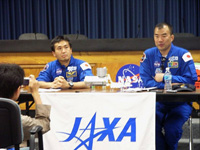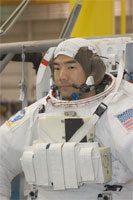Activities of JAXA Astronauts during the STS-124 Mission
The 1J mission (STS-124), the second assembly flight for the Japanese experiment module “Kibo” and on which astronaut Akihiko Hoshide flew as a crew member, was successfully completed with the support from many people on the ground.During the mission, other JAXA astronauts supported the mission in many different aspects.
During the mission, astronauts Takao Doi、Koichi Wakata and Soichi Noguchi held press briefings several times at NASA Johnson Space Center (JSC) and NASA Kennedy Space Center (KSC) to accommodate media corps from Japan and other countries. They briefed the reporters on the launch of space shuttle Discovery and the mission status. Astronaut Wakata mentioned his scheduled long-duration mission with the ISS Expedition 18 and the training astronauts receive at NASA facilities as he responded to reporters’ questions.
Astronaut Naoko Yamazaki supported the mission at JSC as an STS-124 robotics officer and representative from the Astronaut Office. She monitored the operations data of the space shuttle’s robotic arm (Shuttle Remote Manipulator System (SRMS), the space station’s robotic arm (Space Station Remote Manipulator System (SSRMS) or “Canadarm 2”), and Kibo’s robotic arm (JEM Remote Manipulator System (JEMRMS) to give real-time support. Astronaut Yamazaki had reviewed the operations procedures of those robotic arms and attended the operations training before the STS-124 (1J) mission.
Astronaut Mamoru Mohri, who is now Executive Director of the National Museum of Emerging Science and Innovation (“Miraikan”) acted as the master of ceremonies during the JAXA PAO event that was held by connecting the ISS and Miraikan
With the completion of the 1J mission, the only remaining Kibo-designated assembly flight is 2J/A (STS-127). Astronaut Wakata will arrive on the ISS with the 15A (STS-119) mission to start his long-duration mission, and there he will welcome the Kibo’s external experiment platform, the Exposed Facility (EF), and an external stowage pallet called the Experiment Logistics Module-Exposed Section (ELM-ES), which will be delivered to the ISS on the STS-127 mission.
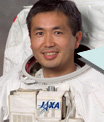 |
In June, I participated in a training session for ISS expedition crew members in Russia after completing my 1J mission support. The training involved a low-pressure chamber that can simulate rapid air depressurization on board the ISS. I was impressed that Russia’s training program for human spaceflight is so well developed and highly matured. Now I’m determined to continue with my training to prepare for my long-duration mission aboard the ISS starting next February, following my fellow astronauts Doi and Hoshide who have successfully completed their tasks in assembling Kibo on orbit. |
ISS Expedition Operations Training in Russia
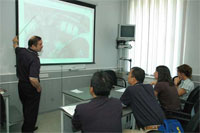
Receiving a lecture at RSC Energia; the lecturer was Pavel Vinogradov, an Expedition 13 crew member.(©S.P.Korolev RSC Energia)
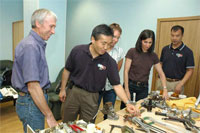
Checking the tools for maintenance and repair of the ISS (from far end astronauts Noguchi, Stott, Magnus, and Wakata) at RSC Energia(©S.P.Korolev RSC Energia)
Astronaut Wakata, who is assigned as an ISS Expedition 18 crew member, participated in an International Space Station (ISS) expedition operations training program held in Russia along with his back-up astronaut Noguchi, as part of preparation for his long-duration mission in the ISS.
During the training program at the Gagarin Cosmonaut Training Center (GCTC) in Russia, astronauts Wakata and Noguchi learned about the Soyuz TMA spacecraft’s attitude control system, propulsion system, the Progress spacecraft’s structural configuration, and how to operate a ham radio station through lectures and training using simulators. Astronaut Noguchi also received training on Soyuz and Progress automated docking systems to the ISS. Using a simulator, the two astronauts learned emergency response procedures and emergency return aboard the Soyuz assuming a fire occurs in a Russian module of the ISS. They also tasted Russian space foods for planning their daily menus.
In addition, astronauts Wakata and Noguchi, along with Sandra Magnus who is assigned as an Expedition 18 crew member and Nicole Stott assigned as an Expedition 19 crew member, participated in a training session held at RSC Energia, the company developing Soyuz and Progress spacecraft. They learned about the design and operations of Progress spacecraft, tools for maintenance and servicing of the ISS, and how to use the amateur radio in the Russian module of the ISS.
Training for the ISS Expedition 20
Astronaut Noguchi, who was assigned as an ISS Expedition 20 crew member, along with NASA astronaut Nicole Stott who is an Expedition 19 crew member, participated in the training session for the Extravehicular Activities (EVAs) at the Neutral Buoyancy Laboratory (NBL) in JSC.
They received training for possible maintenance work during their ISS expedition mission, including replacement of the Flex Hose Rotary Coupler (FHRC), which is part of the Thermal Radiator Rotary Joint that rotates the ISS radiator attached to the S1 and P1 trusses for exhausting heat. The FHRC provides ammonia coolant between the ISS radiator and the ISS trusses. The maintenance of the ISS is vital for the Expedition crew to continue living and conducting experiments on orbit.

